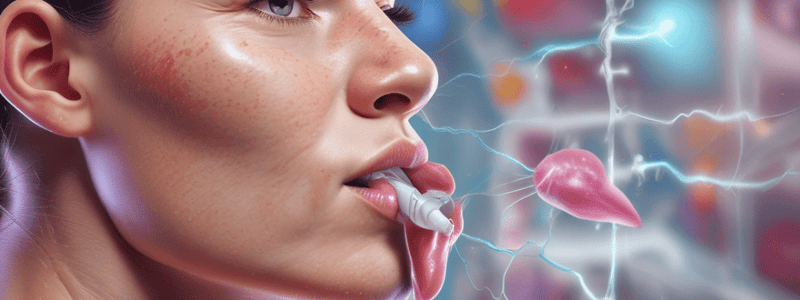Podcast
Questions and Answers
What is the gold standard for testing for malignant hyperthermia?
What is the gold standard for testing for malignant hyperthermia?
- Measuring sarcoplasmic calcium levels
- Genetic testing for the RYR1 gene
- Caffeine-halothane contracture test (correct)
- Evaluating for associated conditions like strabismus or scoliosis
Which of the following is NOT a characteristic of the pathogenesis of malignant hyperthermia?
Which of the following is NOT a characteristic of the pathogenesis of malignant hyperthermia?
- Asymptomatic until triggered by certain anesthetic agents
- Genetic component involving the ryanodine receptor (RYR1) gene
- Increased incidence in older adults compared to children (correct)
- Excessive sarcoplasmic calcium release when triggered
What is the primary underlying cause of the hypermetabolic state seen in malignant hyperthermia?
What is the primary underlying cause of the hypermetabolic state seen in malignant hyperthermia?
- Uncontrolled release of calcium from the sarcoplasmic reticulum (correct)
- Increased activity of the sympathetic nervous system
- Excessive release of acetylcholine at the neuromuscular junction
- Uncoupling of oxidative phosphorylation in mitochondria
Which of the following is NOT a common clinical manifestation of malignant hyperthermia?
Which of the following is NOT a common clinical manifestation of malignant hyperthermia?
Which of the following is a risk factor for postoperative nausea and vomiting (PONV)?
Which of the following is a risk factor for postoperative nausea and vomiting (PONV)?
What is the leading cause of delayed discharge from the post-anesthesia care unit (PACU)?
What is the leading cause of delayed discharge from the post-anesthesia care unit (PACU)?
Which of the following is NOT a cause of temporary pseudocholinesterase deficiency?
Which of the following is NOT a cause of temporary pseudocholinesterase deficiency?
What is the purpose of the dibucaine number test?
What is the purpose of the dibucaine number test?
Which of the following is NOT an example of a disease state that can cause pseudocholinesterase deficiency?
Which of the following is NOT an example of a disease state that can cause pseudocholinesterase deficiency?
What is the significance of pseudocholinesterase deficiency in relation to the use of succinylcholine?
What is the significance of pseudocholinesterase deficiency in relation to the use of succinylcholine?
Which of the following is responsible for the metabolism of succinylcholine?
Which of the following is responsible for the metabolism of succinylcholine?
Flashcards are hidden until you start studying
Study Notes
Malignant Hyperthermia (MH)
- A hypermetabolic state characterized by tachycardia, hyperthermia, hypercarbia, hypoxemia, and acidosis (metabolic)
- Muscle rigidity and DIC are common complications
- Asymptomatic until triggered, typically by exposure to succinylcholine and volatile anesthetic agents
- 3 times greater incidence in children than adults
Genetic Testing for MH
- Gold standard for testing: Caffeine-halothane contracture test
- Genetic component of the ryanodine receptor (RYR1 gene) is associated with MH
Associated Conditions
- Strabismus
- Scoliosis
- Burkitt lymphoma
- Neuroleptic malignant syndrome
- Myelomeningocele
- Congenital hip dislocations
Post-Operative Nausea and Vomiting (PONV)
- Strong association with motion sickness
- Risk factors: female, young, laparoscopic, ear, breast, colon, or eye surgery, non-smoker, use of volatile agents, and use of nitrous oxide
- 30% of all patients undergoing general anesthesia (GA) experience PONV
- 70% of at-risk patients undergoing GA experience PONV
- Leading cause of delayed PACU discharge and 2nd leading cause of hospital re-admission within 24 hours
Pseudocholinesterase Deficiency
- Succinylcholine is the only depolarizing agent used, metabolized by plasma cholinesterase (pseudocholinesterase)
- Prolonged paralysis and apnea can occur due to deficiency
- Genetic component: three distinct allele phenotypes
- Disease states: hepatic failure, malnutrition, acute infection, carcinoma
- Drug therapy: neostigmine, oral contraceptives
- Alterations in enzyme activity: 3rd trimester of pregnancy, newborns, and infants
Dibucaine Number
- Dibucaine inhibits metabolism of a choline substrate by plasma cholinesterase
- Percentage of inhibition of plasma cholinesterase by dibucaine is the dibucaine number
- Dibucaine number can help diagnose pseudocholinesterase deficiency: normal is 80%, atypical is 20%
Studying That Suits You
Use AI to generate personalized quizzes and flashcards to suit your learning preferences.




